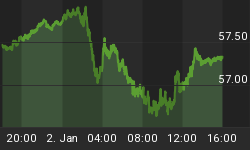Cold Fusion, that pariah of established science, made a comeback in March as the US Navy's Space and Naval Warfare Center went public with results which they believed confirmed that low energy nuclear reactions were present, repeatable and decisively demonstrable in their specialized palladium/heavy water experiments.
I won't bother you with the science of their research (more details here) suffice to say that the debate is again polarized on both sides with supporters calling it an important step in the long road to commercial products while the detractors continue to call it bad science.
However, the assets leveraged towards this kind of announcement hardly reacted at all in price when the press release was made. One gets the feeling the reaction was "We have seen this before" and they would be right to some extent. Exactly twenty years before, the infamous Pons and Fleischman press conference offered to the world a potential new source of energy which was abundant and free from the waste problems associated with conventional nuclear power. Any bull market in Cold Fusion components was quickly snuffed out though as the scientific establishment turned against the two scientists. And that was that for twenty years.
So, will this announcement amount to anything bigger than a hill of radioactive beans? Research institutions across the world that saw some potential in the phenomenon poured millions of dollars since 1989 to no seeming avail. The process was observed successfully in many instances but the scientific mantra of repeatability collided against a volatile and unruly excess heat effect that didn't quite play to the scientific gallery.
Perhaps this time finally the Space and Naval Warfare Center have tamed and caged the Cold Fusion tiger. You can take your side in the debate but if this becomes the real deal will you be positioned to take advantage? As a result of that announcement, I undertook an investigation of the investment potential for Cold Fusion and the best candidates to invest in at this point in time. That is now published in a Cold Fusion Investment Report of which details below.
Those familiar with this investment paradigm will probably say three things - palladium, SWC, PAL and that's all you need to know. In our report we take a look at these three assets (amongst others) and look further afield to where the future of cold fusion investing may lie. We ask some questions such as:
-
Is palladium the only metal that can bring about the Cold Fusion effect?
-
What is the better mining company: SWC or PAL?
-
What about the other palladium mining companies?
-
Why do some forms of palladium not produce Cold Fusion and does that affect some refined palladium products?
-
What is a realistic price projection for palladium if Cold Fusion is commercialized and would such a price make it uneconomical to use?
-
What would be the reaction of governments to such a new and strategic resource?
The world of Cold Fusion investing is not black and white as it may appear and the failed attempt of one promising but now defunct Cold Fusion company (see the report) testifies to the fact that one should not jump on the first bandwagon that takes to that road.
Take for example the question of government. What has government got to do with this anyway? Well for a start they funded the research mentioned at the top of the article but more importantly any resource that attains strategic importance begins to get more and more State attention.
Back in 1933, gold ownership was banned as US government policy morphed into a socialist scenario that saw "public necessity" trump individual wealth preservation. The same held true of silver in 1934 but for larger bullion amounts.
If palladium becomes a saviour of alternate energy policy, does government stand back and let the free market take the price of palladium to the stratosphere or will they act to seize all palladium holdings, freeze the various palladium ETFs and license the output of palladium mines in their domain? It is a likely scenario but when and how is as yet unknown. The remit of the investor is to see the telltale signs of government rumblings and exit quickly (for example, Roosevelt banned all silver exports just days before the executive order confiscating large private holdings of silver bars).
Another example is the supposed leverage that palladium mining companies offer over the metal. This is a well known strategy amongst precious metals investors but during the palladium bull of 1999-2001, Stillwater Mining Company miserably underperformed palladium. Why was that and how can one decide the mix of bullion and equities as such a future time? Well, you can't but investors at least need to be aware of the risks involved ahead of time.
Cold Fusion is real, but the transformation from a scientific experiment to a commercial product is not there yet. If (or when) it happens and commercial companies begin to pour serious money into finally nailing down the process, I believe palladium will begin a bull market that will dwarf the one that spiked to nearly $1100 per ounce on Russian stockpile problems.
Further details of this special report are at our silver blog (http://silveranalyst.blogspot.com) where readers can also obtain a free issue of The Silver Analyst and learn about subscription details. Comments and questions are also invited via email to silveranalysis@yahoo.co.uk.
















